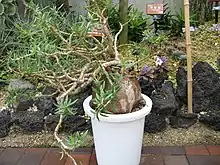| Pachypodium bispinosum | |
|---|---|
 | |
| Potted specimen of Pachypodium bispinosum at the Osaka Prefectural Flower Garden in Osaka, Japan | |
| Scientific classification | |
| Kingdom: | Plantae |
| Clade: | Tracheophytes |
| Clade: | Angiosperms |
| Clade: | Eudicots |
| Clade: | Asterids |
| Order: | Gentianales |
| Family: | Apocynaceae |
| Genus: | Pachypodium |
| Species: | P. bispinosum |
| Binomial name | |
| Pachypodium bispinosum (L.f.) A.DC. | |
| Synonyms | |
|
Belonites bispinosus (L.f.) E.Mey | |
Pachypodium bispinosum is a succulent sub-shrub in the family Apocynaceae.[1][2]
Description
Pachypodium bispinosum has a swollen, tuberous stem, or caudex, up to 0.6 m tall, which is partially buried beneath the soil. Thick, bonsai-like branches sprout from the top of the stem, and are lined with paired, straight spines 10–20 mm long, somewhat shorter than other Pachypodium species. The narrow leaves are scattered or in tufts along the branches. From August to December, the plant bears a few purple to pink flowers in clusters at the tips of the branches. These flowers are bell-shaped are about 15–20 mm in diameter. P. bispinosum is the most floriferous species in cultivation. The leaves of this species are less hairy than others in its genus, with margins curling down more distinctly.[3]
Distribution
The species is almost entirely confined to the Eastern Cape Province of South Africa. In its native range, it can be found in stony places, growing amongst the dry succulent scrub. When not in flower, it is indistinguishable from Pachypodium succulentum, a species with which it overlaps in its natural range.[3]
References
- ↑ "Pachypodium bispinosum (L.f.) A.DC". theplantlist.org. Retrieved 6 May 2015.
- ↑ "Pachypodium bispinosum (L. f.) A. DC". African Plant Database. Conservatoire et Jardin botaniques & South African National Biodiversity Institute. Retrieved 6 May 2015.
- 1 2 "Pachypodium". PlantZAfrica.com. South African National Biodiversity Institute. Retrieved 6 May 2015.